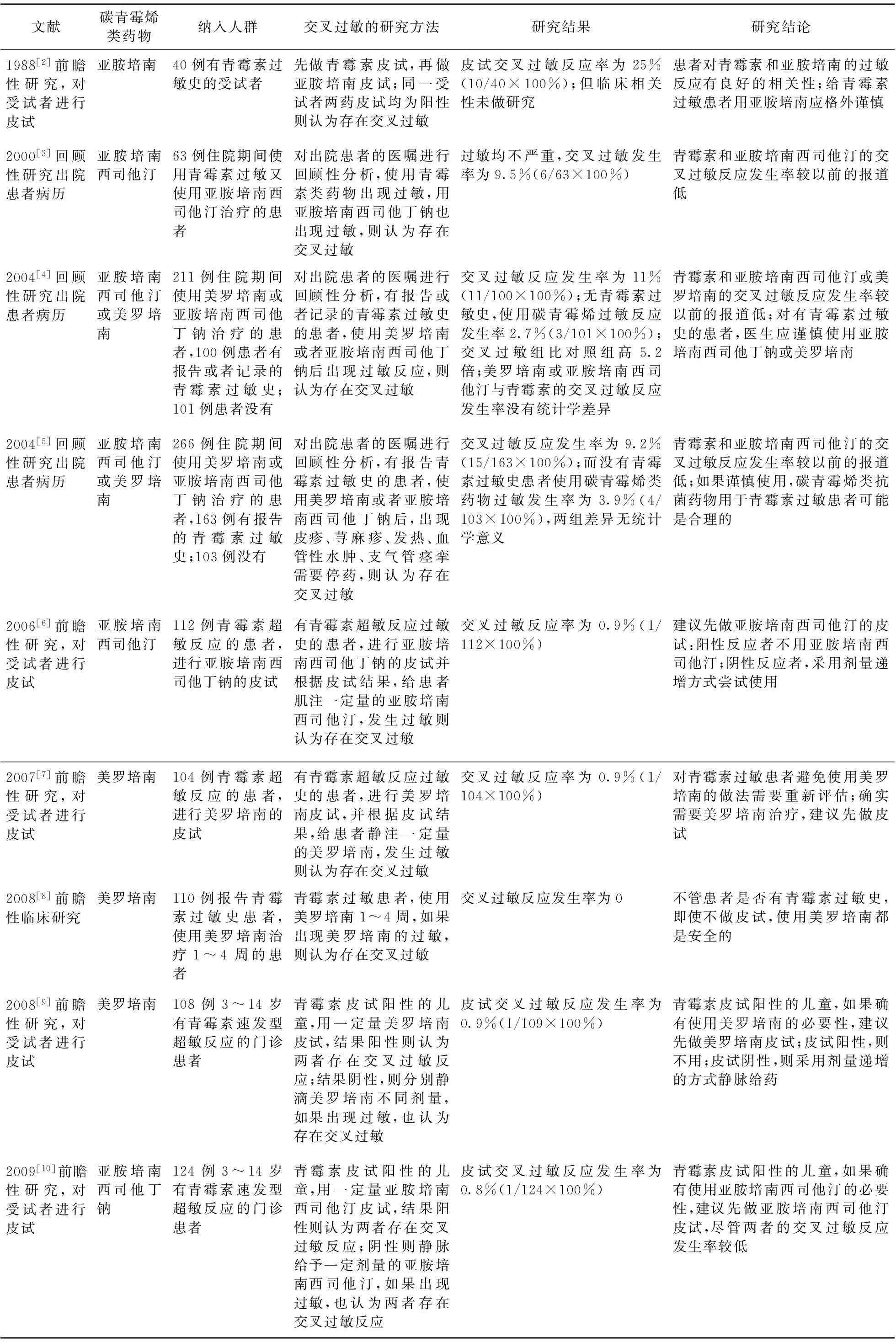美罗培南与哌拉西林他唑巴坦交叉过敏反应一例并文献分析
马丽萍,陈 灿,张 蕾,赵继红,吝战权,沈司京*
1.北京大学首钢医院药剂科,北京100144;2.北京大学药学院临床药学专业,北京100871
·安全用药·
美罗培南与哌拉西林他唑巴坦交叉过敏反应一例并文献分析
马丽萍1,陈灿1,张蕾2,赵继红1,吝战权1,沈司京1*
1.北京大学首钢医院药剂科,北京100144;2.北京大学药学院临床药学专业,北京100871
[摘要]目的探讨IgE介导的青霉素过敏患者能否安全使用碳青霉烯类抗菌药物。方法结合1例美罗培南与哌拉西林他唑巴坦交叉过敏反应的临床案例,检索2015年1月之前国内外研究碳青霉烯类和青霉素类药物交叉过敏反应的文献,共收集到相关文献11篇(2 308例受试者),分别从“研究药品、纳入人群特点、交叉过敏的研究方法、研究结果和结论”等5个方面进行统计和分析。结果亚胺培南与青霉素的交叉过敏反应发生率在0.8%~25%之间,美罗培南与青霉素的交叉过敏反应发生率在0~0.9%之间;交叉过敏反应的主要表现为皮疹、皮肤瘙痒、药物热、喘憋、中性粒细胞减少、面部水肿、呼吸窘迫、关节痛、急性中性粒细胞减少、急性肾功能衰竭和血管内溶血等。结论对于有青霉素过敏史或者皮试阳性的患者,医生应详细询问患者青霉素过敏情况(相关药品、发生时间和类型、严重程度等);确有必要使用碳青霉烯类药物时,应谨慎使用并进行密切监护,必要时进行脱敏治疗或在床旁准备过敏抢救药品和设施。
[关键词]碳青霉烯;青霉素;交叉过敏反应
1病例资料
患者,男,78岁,身高162 cm,体重约45 kg,主因“慢性咳痰喘50年,加重伴精神差1 d”于2015年1月9日入我院肾内科治疗,查体:体温37.1 ℃,脉搏96次/min,呼吸36次/min,血压110/60 mmHg;血象:白细胞6.5×109/L、中性粒细胞67.7%;降钙素原0.166 μg/L;既往:癫疒间60年,间断发作;脑梗死10年,生活自理,但存在饮水呛咳,无其他疾病史,否认药物食物过敏史,但本次急诊哌拉西林他唑巴坦皮试阳性;入院诊断:①慢性喘息性气管炎伴继发感染(混合性酸碱平衡失调,Ⅱ型呼吸衰竭);②脑梗死后遗症;③癫疒间。1月9日下午至1月10日输注美罗培南(1 g/次,bid)3次后,1月10日21∶20病程记录患者出现挠头挠脸现象,提示皮肤瘙痒,查体见面部有抓痕但未见皮疹,肌注异丙嗪未见缓解,患者烦躁,21∶50喘憋加重,胡言乱语;查体心率108次/min、呼吸50次/min、氧分压95%、血压138/78 mmHg,给予静滴甲泼尼龙、肌注吗啡、尼可刹米支持呼吸等治疗,患者过敏反应减轻。1月14日,医嘱继续美罗培南(1 g/次,ivgtt,bid)抗感染,但联合使用抗过敏药物西替利嗪(10 mg/次,qd,13~15日);14日,药师审核医嘱时,发现该患者哌拉西林他唑巴坦皮试阳性,但医嘱中使用美罗培南抗感染;结合1月10日患者输注美罗培南后的临床表现,药师详细询问了患者家属用药过程中患者的表现;患者家属诉患者每次输完美罗培南都出现挠头挠脸现象,有时烦躁,有时候喘憋加重。结合1月10日患者输完美罗培南后的病程记录情况,药师怀疑该患者可能存在美罗培南与哌拉西林他唑巴坦交叉过敏反应现象,遂建议医生停用美罗培南,改为左氧氟沙星抗感染。医生采纳药师建议,1月14日停用美罗培南后,患者未再出现挠头挠脸等皮肤瘙痒表现,喘憋现象也有好转。根据国家不良反应的判定标准:该患者输注美罗培南后出现皮肤瘙痒表现,停药后消失,且皮肤瘙痒在美罗培南说明书中也有提及,因此,判定该不良反应的级别为很可能;结合患者此次哌拉西林他唑巴坦皮试阳性,且哌拉西林和美罗培南均为β内酰胺类抗菌药物,有结构的相似性,该患者很可能发生了美罗培南与哌拉西林他唑巴坦的交叉过敏反应。
2文献分析
2.1为了解碳青霉烯类药物和青霉素类药物交叉过敏反应(IgE介导的超敏反应)的研究进展,明确青霉素过敏患者能否使用碳青霉烯类抗菌药物,本文采用Liberati等[1]介绍的文献综述和评价方法,检索Pubmed、Medline(ovid)、Embase (ovid)、cochrane图书馆、VIP、CNKI及万方数据库,检索时限为建库至2015年1月;查找研究碳青霉烯类抗菌药与青霉素类药物交叉过敏反应的研究,除外案例报道;查找关键词为“carbopenem” and “penicillin” and “hypersensitivity” or “cross reactions”,经阅读题目、摘要或者全文等方式,筛选出碳青霉烯类药物与青霉素交叉过敏反应的研究性文献11篇[2-12],包括7篇前瞻性研究[2,6-10,12]和4篇回顾性研究[3-5,11],检索结果见表1。

表1 碳青霉烯类药物与青霉素交叉过敏反应的研究性文献
2.2文献分析相关文献共11篇[2-12],2 308例受试者,碳青霉烯类药物与青霉素交叉过敏反应发生率约为0~25%;其中专门研究亚胺培南西司他丁钠与青霉素交叉过敏的文献共4篇[2-3,6,10],215例受试者,两者交叉过敏发生率在0.8%~25%之间;专门研究美罗培南与青霉素交叉过敏反应的文献共3篇,322例受试者,两者交叉过敏反应发生率在0~0.9%之间[7-9];有一篇研究表明,有青霉素过敏史患者使用碳青霉烯类药物比无青霉素过敏史患者高5.2倍[4];有两篇文献报道有青霉素过敏史患者和无青霉素过敏史患者使用碳青霉烯类药物过敏发生率差异无统计学意义[5,11];尽管有多篇文献报道碳青霉烯类药物与青霉素交叉过敏反应发生率较低,但也有多篇案例报道同一患者对两种药品均过敏[13-15],提示两药存在交叉过敏反应的可能性;交叉过敏反应主要表现为皮疹[3-5]、皮肤瘙痒[5]、药物热[4-5]、喘憋[4]、中性粒细胞减少[5]、面部水肿[5]、唇部肿胀[ 5]、呼吸窘迫[4]、关节痛[4 ]、急性中性粒细胞减少[4]、急性肾功能衰竭[3]和血管内溶血[13]等。
3讨论
青霉素类抗菌药物可以引起多种类型的过敏反应,而IgE介导的过敏反应(如皮肤瘙痒、荨麻疹、血管神经性水肿、气喘和喉头水肿等)可直接威胁患者生命;青霉素类和碳青霉烯类抗菌药物均属于β内酰胺类抗菌药物,具有相似的化学结构(β内酰胺环),因此,两者可能存在交叉过敏反应。为了解具有青霉素过敏史或者青霉素皮试阳性的患者能否安全使用碳青霉烯类抗菌药物,本文结合1例哌拉西林他唑巴坦皮试阳性患者使用美罗培南后出现皮肤瘙痒和喘憋现象的临床案例,详细分析了青霉素类抗菌药物和碳青霉烯类抗菌药物交叉过敏反应的发生情况,为临床合理用药提供参考。
3.1交叉过敏反应的发生率本文共纳入11项研究,其中4篇研究了亚胺培南西司他丁钠与青霉素交叉过敏反应发生率(0.8%~25%),3篇研究了美罗培南与青霉素交叉过敏反应发生率(0~0.9%)。有1篇文献比较了美罗培南和亚胺培南西司他丁钠与青霉素交叉过敏反应发生率的差异,表明两种碳青霉烯类抗菌药物与青霉素交叉过敏反应发生率差异无统计学意义。
3.2交叉过敏反应的临床表现11篇研究青霉素与碳青霉烯类抗菌药物交叉过敏反应的文献中,有3篇文献报道了交叉过敏反应的表现,其中皮疹的不良反应发生率较高,而急性肾功能损伤和血管内溶血不良反应发生率较低,但较为严重,且容易与其他疾病混淆,应引起医务人员警惕;有3篇案例报道青霉素和碳青霉烯类抗菌药物可能发生了交叉过敏反应,表现为皮试均为阳性、血管内溶血等;因此,对于青霉素过敏史或者青霉素皮试阳性的患者使用碳青霉烯类抗菌药物应谨慎。
4结论
尽管有多篇研究表明青霉素类抗菌药物和碳青霉烯类抗菌药物的交叉过敏反应发生率较低,但对于有青霉素过敏史的患者,医生应详细询问青霉素过敏的表现,了解过敏的严重程度、发生时间、相关药品和过敏类型,对于青霉素过敏较为严重或者皮试阳性的患者,确实有使用碳青霉烯类抗菌药物的指征,应在患者床旁准备过敏抢救的药品(如肾上腺素)和仪器设备,给予脱敏治疗或者采用剂量递增方式观察患者的耐受性;而对于青霉素过敏较轻的患者,确有必要使用碳青霉烯类抗菌药物时,应在首次用药时严密监测患者的症状和体征,及时发现和治疗药物引起的过敏。
参考文献:
[1]Liberati A,Altman DG,Tetzlaff J,et al.The PRISMA statement for reporting systematic reviews and meta-analyses of studies that evaluate health care interventions: Explanation and elaboration[J].Ann Intern Med,2009,151(4):W65-W94.
[2]Saxon A,Adelman DC,Patel A,et al.Imipenem cross-reactivity with penicillin in humans[J].J Allergy Clin Immunol,1988,82(2):213-217.
[3]McConnell SA,Penzak SR,Warmack TS,et al.Incidence of imipenem hypersensitivity reactions in febrile neutropenic bone marrow transplant patients with a history of penicillin allergy[J].Clinical Infectious Diseases,2000,31(6):1512-1514.
[4]Prescott WA Jr,DePestel DD,Ellis JJ,et al.Incidence of carbapenem-associated allergic-type reactions among patients with versuspatients without a reported penicillin allergy[J].Clin Infect Dis,2004,38(8):1102-1107.
[5]Sodhi M,Axtell SS,Callahan J,et al.Is it safe to use carbapenems in patients with a history of allergy to penicillin[J].J Antimicrob Chemother,2004,54(6):1155-1157.
[6]Romano A,Viola M,Guéant-Rodriguez RM,et al.Imipenem in patients with immediate hypersensitivity to penicillins[J].N Engl J Med,2006,354(26):2835-2837.
[7]Romano A,Viola M,Guéant-Rodriguez RM,et al.Brief communication: tolerability of meropenem in patients with IgE-mediated hypersensitivity to penicillins[J].Ann Intern Med,2007,146(4):266-269.
[8]Cunha BA,Hamid NS,Krol V,et al.Safety of meropenem in patients reporting penicillin allergy: lack of allergic cross reactions[J].J Chemother,2008,20(2):233-237.
[9]Atanaskovié-Markovié M,Gaeta F,Medjo B,et al.Tolerability of meropenem in children with IgE-mediated hypersensitivity to penicillins[J].Allergy,2008,63(2):237-240.
[10]Atanaskovié-Markovié M,Gaeta F,Gavrovié-Jankulovié M,et al.Tolerability of imipenem in children with IgE-mediated hypersensitivity to penicillins[J].J Allergy Clin Immunol,2009,124(1):167-169.
[11]Wall GC,Nayima VA,Neumeister KM.Assessment of hypersensitivity reactions in patients receiving carbapenem antibiotics who report a history ofpenicillin allergy[J].J Chemother,2014,26(3):150-153.
[12]Gaeta F,Valluzzi RL,Alonzi C,et al.Tolerability of aztreonam and carbapenems in patients with IgE-mediated hypersensitivity to penicillins[J].J Allergy Clin Immunol,2015,135(4):972-976.
[13]Lambden SP,Akeru J,Barrett NA.Acute intravascular haemolysis associated with intravenous administration of meropenem in asixty four year old man[J].Can J Clin Pharmacol,2010,17(1):e64-e66.
[14]Wilson DL,Owens RC Jr,Zuckerman JB.Successful meropenem desensitization in a patient withcystic fibrosis[J].Ann Pharmacother,2003,37(10):1424-1428.
[15]Gorman SK,Zed PJ,Dhingra VK,et al.Rapid imipenem/cilastatin desensitization for multidrug-resistant Acinetobacter pneumonia[J].Ann Pharmacother,2003,37(4):513-516.
Literature analysis of one case of cross allergic reaction between meropenem and piperacillin-tazobactamMA Li-ping1,CHEN Can1,ZHANG Lei2,ZHAO Ji-hong1,LIN Zhan-quan1,SHEN Si-jing1*(1.Department of Pharmacy,Peking University Shougang Hospital,Beijing 100144,China;2.College of Pharmacy,Peking University,Beijing 100871,China)
[Abstract]ObjectiveTo determine if carbapenems can be safely prescribed for patients who have had presumed IgE-mediated reactions to penicillins.MethodsCombined with one case about cross allergic reaction between meropenem and penicillin,2 308 subjects participated in the studies of cross allergic reaction between carbopenems and penicillin in 11 literatures were collected from the establishment of a database to January 2015 and analyzed from five aspects of study related drugs,included population characteristics,cross-allergy research methods,findings and conclusions of researches.ResultsThe incidence of cross allergic reactions between imipenem and penicillin was 0.8%~25%,and the incidence of meropenem and penicillin was 0~0.9%;The main cross allergic performances included rash,pruritus,drug fever,wheezing,neutropenia,facial edema,respiratory distress,joint pain,acute neutropenia,acute renal failure and intravascular hemolysis.ConclusionFor patients with a history of allergy or skin positive test of penicillin,the doctor should obtain a detail allergic history that include the specific penicillin,the type,the severity,and the date the reaction occurred.When a carbapenem is necessary and administered in any patients with a suspected penicillin allergy,caution should be exercised and the patient should be closely monitored for signs and symptoms of drug hypersensitivity;Desensitization therapy or the ready of rescuing allergy medicines at bedside is necessary.
Key words:Carbapenem;Penicillin;Cross-allergic reactions
DOI:10.14053/j.cnki.ppcr.201601022
*通信作者
收稿日期:2015-06-04

